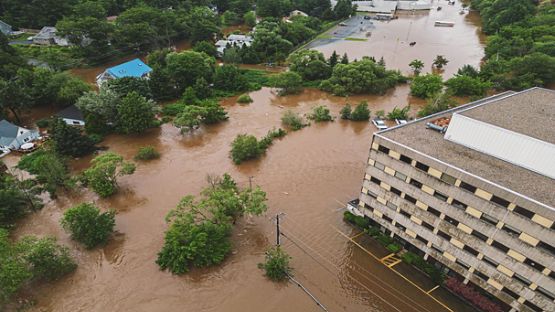Hurricanes, wildfires, floods, and other natural catastrophes (CATs) are becoming more common and severe globally. According to the Swiss Re Institute, the insurance loss burden from CATs has more than doubled over the last 30 years. They predict that this could grow by 5-7% in the coming decade.
In Canada, 7 of the 10 largest CAT losses have occurred within the last 10 years. In 2023, the insurance industry paid out $3.1 billion in damages across 14 CAT events.1
“CAT events are not limited to one region or part of the country. They’re happening from coast to coast, with greater frequency and intensity every year,” Paul Tsipas, AVP of GCS Corporate Property at Aviva Canada, told the RIMS Canada conference.
“In 2023, Aviva had almost 8,000 claims across 17 CAT events that incurred $200 million in losses. This year is projected to be even higher. In the summer of 2024 alone, we had four major CAT events within four weeks, including torrential rains and flooding in Ontario and Quebec, and a hailstorm in Calgary that was the single costliest event for Aviva in Alberta since the Fort McMurray wildfires in 2016.”
What is the impact of CATs on insurance premiums?
In his presentation, Tsipas outlined three ways Aviva Canada manages and forecasts the impact of CATs on premiums, allowing for accurate, reasonable, and personalized prices.
Buying reinsurance
Being part of a reinsurance treaty allows insurers to spread out and share portions of risk. Like most insurers, Aviva Canada purchases CAT reinsurance every year to protect against events with significant payouts.
“Divesting some of the risk not only helps us with financial stability but ensures we have enough capital to pay out claims when they occur. It allows us to meet regulatory requirements as well,” said Tsipas.
Reinsurance also helps Aviva stabilize premiums for our policyholders. “By mitigating the financial impact of large claims, we can avoid significant premium increases after a CAT.”
Modelling
Using natural catastrophe modelling systems such as Moody’s RiskLink and Verisk to assess risk is another way Aviva helps determine CAT risk exposures in specific areas.
“These modelling tools use advanced computer technology to simulate potential CAT events and estimate the resulting financial losses,” said Tsipas.
He pointed to three key areas where modelling is used to help determine Aviva’s CAT risk capacity and set realistic premiums.
Hazard recognition
“Modelling helps us identify and understand if an exposure lies in an extreme or high hazard zone, or if the exposure is in a low hazard zone,” said Tsipas.
“This involves analyzing historical data and using statistical models to predict future events. Hazard recognition helps identify regions that are most likely to be affected by different types of natural disasters in the coming year.”
Marginal impact analysis
“Modelling allows us to see how our existing portfolio will be impacted when we add a new risk onto our book. This is crucial in managing our portfolio and adjusting our reinsurance strategy to align with our growth targets,” said Tsipas.
Annual average loss (AAL)
“AAL refers to the expected annual average financial loss per year due to natural disasters. It’s calculated by simulating a large number of potential CAT events over many years and averaging the total losses from these events,” said Tsipas, “We use this metric for setting insurance premiums and setting reserves”.
Underwriting judgment
Another component of premium setting involves the insights and analyses of underwriting professionals within Aviva. According to Tsipas, underwriting judgement involves a combination of factors and questions that help them determine an individual client’s premium rate:
Customer needs
“When we understand the needs of our customers, underwriters can accurately assess the risks involved. This usually leads to better pricing.”
Coverage options
“What type of coverage does a client require? For example, they may have an exposure in a high hazard CAT zone and are looking to purchase a certain amount of coverage. The potential of loss in these high hazard zones increases and affects that premium. Deductibles are also part of the equation—the larger the deductible, the lower the rate.”
Data quality
“Better data allows us to accurately assess the risk and usually results in better pricing. For example, providing accurate Construction Occupancy Protection Exposure (COPE) details not only helps with the fire rate but improves CAT modelling results.”
Risk management
“What is the insured’s philosophy and approach when it comes to risk management? Clients who implement effective risk management practices, such as safety and housekeeping protocols, contingency plans, building and equipment maintenance and who follow recommendations such as capital expenditure allocations are less likely to suffer a loss. Pricing will reflect this.”
Loss experience
“With the help of our actuaries, underwriters analyze past claims to predict future claims. We use historical data to set premiums that accurately reflect the potential costs of future claims. This ensures premiums are fair and sufficient to cover potential losses.”
Premium pricing, particularly with the increasing number and severity of CATs, is always evolving. Using data science and modelling, astute financial management practices, and the professional judgment of underwriting and actuarial professionals, Aviva Canada aims to offer fair premiums for each client based on their needs.
Looking to protect your business against new and evolving risks?
Aviva’s Global Corporate & Specialty team offers a prevention-first approach that combines technological innovation with risk management. If your large corporate business requires protection, with expert claims management and dedicated support, our team can help.
1 Severe Weather in 2023 Caused Over $3.1 Billion in Insured Damage













